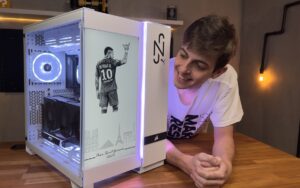
In about 8 months, the Criterion Games managed to develop a game that remains in the imagination of many – including mine. A true guide on how to deliver a game that doesn’t take itself seriously, is highly entertaining and deserves to be revisited. Burnout 3: Takedown.
Released in September 2004 for PS2 and Xbox, Burnout 3 Takedown, distributed by EA, was one of the many titles that I first came across in one of the beloved console LAN houses. A place to play, interact with other players, and get in touch with new titles.
Entering the place and seeing that row of video games, with people with their eyes glued to the screen, was an invitation to have fun. On one of those occasions I saw someone playing Burnout 3: Takedown, and within a few seconds I was sure that this was the game I would invest my scarce money in, reserving a few hours on one of the PS2 units available for use.
A manual on how to make an excellent arcade racing game
The feeling of a certain subversion to what is very moralistic and correct, something that usually captivates young people (or at least it was like that), was rooted in Burnout 3: Takedown.
It wasn’t just an ode to racing, it was a declaration of love for combat, confrontation, and eliminating the opponent, all of this accompanied by an incredible sense of speed, impact explosions, and a soundtrack that accompanies the rhythm: 44 tracks from bands like Fall Out Boy, Ramones, and New Found Glory.
Starting with the opening with “We Are The Lazy generation” by the punk band F-Ups, with countless takes of cars flying, crashing, concluding with an explosion and the game logo appearing. Flawless!
“The Burnout 3 soundtrack exemplifies the game’s musical personality in terms of defiance, rebellion and anguish”defined Steve Schnur, who at the time was already working as an executive in the music department at Electronic Arts, in an interview with the September 2004 issue of Billboard.
The game remains true to its fun and entertainment values, with its many variations in career mode, such as the frenetic Crash Mode, which basically consists of crashing into everything and causing damage, and Eliminator, in which the driver in last place is eliminated every lap. This is the game mode in Burnout 3: Takedown that I always liked the most. The number of vehicles available is also quite varied, allowing you to play with muscle cars, sports cars with bold designs, Formula 1 cars, among others.
In addition to other offline and single-player modes, the game could also be played online (I never tested this part), and it also had multiplayer, which put any friendship at risk.
Burnout 3: Takedown was the first game in the franchise that I came into contact with, and I confess that I ended up not playing the others much. I did test the next title, Revenge, which I also liked, and I also remember playing Burnout Paradise, which even got a remastered version in 2018.
But the remaster I’m still waiting for is Burnout 3: Takedown, a high point in the history of arcade racing games, with Takedown as its star attraction, the move of blocking your competitors, throwing them out of the race, the art of aggressive street racing.
Watching the slow-motion replay, capturing the exact moment you finish off your competitor, performing a takedown, watching the car go flying, was really cool, adding a cinematic aspect to the collisions. A Zack Snyder-esque level of drama.

In a vision beyond reach, in the style of Lion from Thundercats, EA, which was a partner of Criterion in the distribution of the game, ended up becoming the owner of everything. Seeing the enormous potential that was ahead of it, EA bought Criterion, which belonged to Canon, in the same year that Takedown was released. The studio formed in 1996, and which already had 9 games under its belt, including the two previous Burnouts (distributed by the defunct Acclaim Entertainment), would now be run by Electronic Arts.
EA was absolutely shrewd in promoting the game, even betting on a joint promotional strategy, which involved another super racing game. Need for Speed Underground 2.
The PS2 version of NFS included a demo of Takedown, while the copy of Burnout 3: Takedown included a demo of Need for Speed Underground 2. The release gap between these two games was 3 months.
Burnout 3 Takedown came out on September 3, 2004, and Need For Speed Underground 2 was released on November 9 of that year.
In 2004, a game was also released that, like Burnout 3: Takedown, placed a lot of emphasis on the issue of collisions, Flatout, produced by Bugbear Entertainment and published by Empire Interactive.
Well, if you like high speed, good graphics, considering the time of release, things flying all the time, a great soundtrack and you classify yourself as an adrenaline junkie, it’s worth playing again – just like I did -, or getting in touch for the first time with Burnout 3: Takedown.
Source: https://www.hardware.com.br/artigos/joguei-novamente-burnout-3-takedown/


